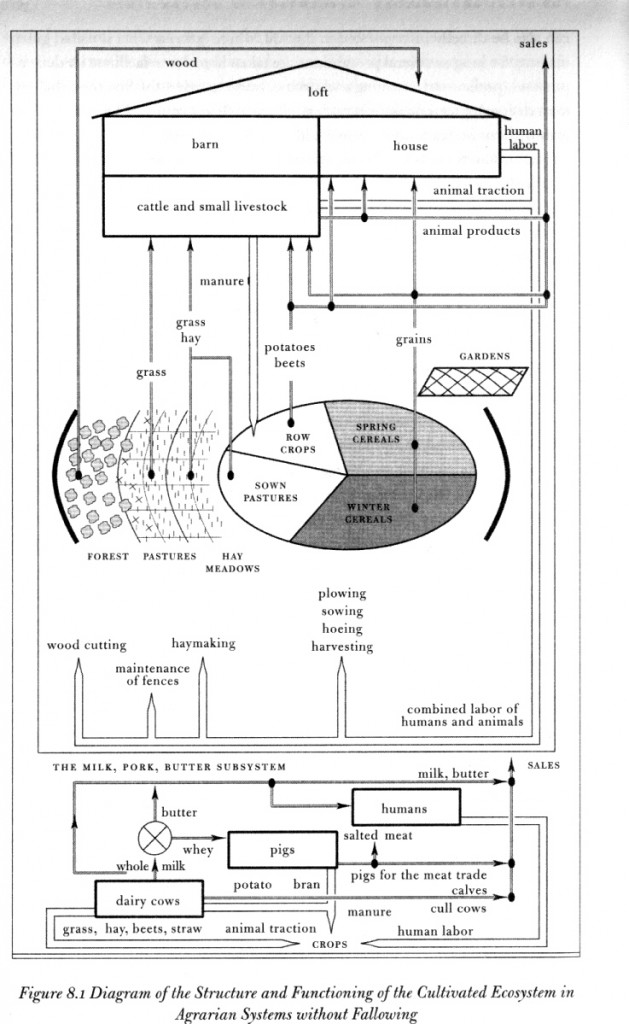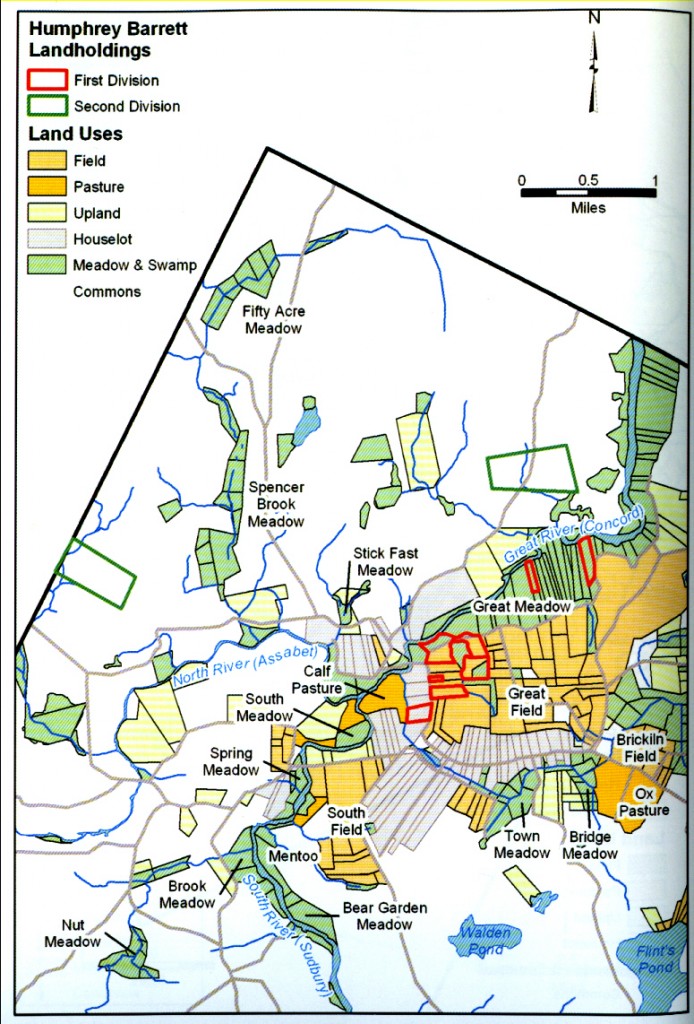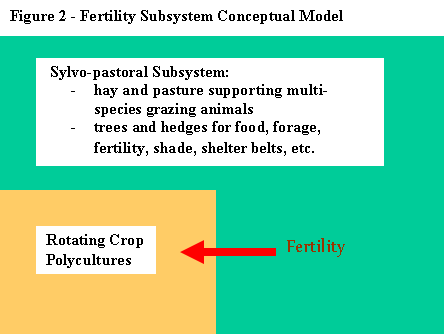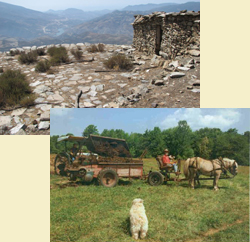« A systems view of Western policy today | Home | Energy and Sustainability in Late Modern Society »
Human designs for ecosystem management and survival after the oil era
By Karl North | January 18, 2020
All societies in history have relied on the land and its plant and animal resources. The superstructure of high technologies and complex forms of social organization like cities that fossil energy has made possible only conceal our essential reliance on the land. As access to the dense, high quality forms of energy in fossil fuels declines, it will force human society to return to modes of land management that use current solar gain and the low energy technologies that it provides[1].
Natural ecosystems offer an excellent guide to the kind of land management that will be necessary, because they run on current solar gain and rely heavily on their internal resource base for inputs. Long before the advent of our species, life self-organized into complexes of species that we now call ecosystems, whose interaction achieved two important synergies:
- They often maximized the carrying capacity of the system – the maximum biomass that the land could support.
- They also achieved a degree of self-regulation via food webs – a matrix of predator-prey and cooperative relationships – that enhanced the sustainability of the whole.
Pre-industrial societies, whether hunter/gatherer, horticultural, pastoral or a combination, learned to benefit from these interactions. Ecosystem science can build on and improve these pre-industrial schemes of land management. Modern knowledge of how ecosystems work can be used to enhance ecosystem processes that are essential to the health and long-term productivity of farms, when they are managed as agroecosystems. This essay will draw on current ecological knowledge to present general design elements and principles of land management to maximize long-term productivity for two types of environments: wet, temperate and relatively dry, seasonal rainfall locations.
These are not the environments that offer the highest potential carrying capacity. Locations where constant irrigation is possible are potentially the most productive, all other things being equal. Early agricultural societies built high “hydraulic” civilizations on rivers like the Nile or the Mekong, on reconfigured wetlands[2], on seasonal floodplains[3], and where high rainfall allowed water capture for wet rice systems[4]. However, they are less common than wet temperate locations such as Eastern North America or Northern Europe, or seasonal rainfall areas like African savannas, dry Asian steppes or the high prairies of Western North America. Hence the focus here; it is these latter two types, lands that most human populations will need to learn to manage sustainably if they are to survive as the industrial era melts away.
Modern systems ecology affords an understanding of how ecosystems function as complex, integrated wholes which, applied to agroecosystem management, shifts the goal from managing to maximize short run outputs to managing for the health of the system. The health of the ecosystem rests in turn on the health of the ecosystem processes: the energy flow, the mineral cycles, the water cycle and the interaction and interdependence of species. Ecosystem science has demonstrated that this holistic approach, while it may involve short run investments that sacrifice output, can improve outputs in the long run and at the same time sustain the system over the long term[5]. The strategy of management for short term outputs instead of the health of the ecosystem bears much of the responsibility for land degradation and the collapse of most civilizations since the advent of agriculture[6]. Systems ecology thus represents a revolution in thinking, a worldview that will inform the agroecosystem designs in this essay.
An essential principle of agroecosystem design in most environments is the integration of animals in relation to other species in the system, especially the plant base. Ecologists call the plant base the primary producers because photosynthesis in plants is the point of entry of solar energy into the ecosystem. That base becomes the source of energy flow in the system throughout the web of its predator-prey and sharing/trading relationships. Hence, strategies that enhance primary producer production raise the production potential and the health of the whole agroecosystem. Grazing animals have many uses, but a central function in design is to use them in a way that maximizes primary producer growth.
An example developed centuries ago is the loose cooperation between nomadic pastoralists and sedentary farmers on the West African savanna and sahel, despite being of different ethnic groups. Fula herders followed the seasonal rains north into the sahel and Sahara. Farmers like Bambara or Malinke allowed the pastoralists to return south in the dry season and settle their livestock on the cultivated fields and fallows of the farmers, gleaning and manuring them, and trading grain for milk.
Grazers in wet temperate environments
In many parts of the world, traditional models of agriculture that integrated crops and livestock to various degrees have endured for many centuries in a range of climates. For our purposes, a most interesting improvement on these models developed in areas of Europe that have a cool, wet climate comparable to our situation in the Northeastern US. In their last agricultural revolution before the industrial age, lowland European farmers created a model of animal/crop integrated farming that supported new levels of human population density (see figure)[7]. Previously, a fallow rotation had been necessary to renew fertility, and it supported a few livestock. The revolution consisted of intensive production of perennial and annual forage species for ruminants on the fallow rotation, which in turn allowed higher stocking rates, more barnyard manure, better utilization of pasture manure, and higher fertility and production on the whole farm. Pursued to its limit, this positive feedback loop allows the farmer to maximize the carrying capacity potential of the land.
Enduring examples in other parts of the world of this increasingly tight integration between cultivation and animal husbandry, using different configurations of plants and animals, underscore its advantages, which in the best cases use animals as multi-purpose tools to produce labor, fertility and food.
As early as 1650, colonists in New England had adapted animal integrated systems developed in lowland England (Donahue 2004). In colonial Concord, community land use policy supported the needs of an integrated system (see diagram). Riverine flood plain areas were managed as a swamp commons mostly reserved for pasture and hay as they dried out during the growing season. Adjacent fertile land was allocated for cropping, but became a grazing commons after harvest. Upland was multi-purpose, with the higher land maintained in forest. As in parts of Europe, well-watered riverine meadows fed with water-born silt produced enough livestock feed, livestock, and manure to sustain the fertility of land in tillage.
The next major revolution for our purposes was first documented in detail by the French farmer/scientist, André Voisin[8]. High organic matter soils are central to achieving healthy water and mineral cycles, and soils in humid temperate regions are exceptional in their ability to store organic matter and accumulate it over a period of years. Voisin’s book Grass Productivity demonstrated fifty years ago that pulsed grazing on permanent pasture is the fastest soil organic matter building tool that farmers have, at least in temperate climates. Pulsed Grazing is a method of repeated grazing of paddocks in a pasture that controls stock density and timing of stock movement in and out of paddocks to maximize forage production over the growing season. This in turn maximizes manure production to build soil organic matter. Forage plants experience repeated pulses of growth and removal of biomass, both above and below ground, over the growing season. The increase in primary production enhances the carrying capacity of the whole agroecosystem. Its key points:
- Grazing causes forage roots to die back, which adds soil organic matter from the dead root mass. High stock density tramples ungrazed forage into litter that decomposes into soil organic matter.
- Stock enter a paddock before forage growth proceeds from its vegetative stage to seed production, after which growth slows and leaf quality diminishes.
- Stock leave a paddock while there is still sufficient forage leaf area to jump-start regrowth, and uneaten forage has been trampled into litter.
- Stock return to the same paddock when leaf and root regrowth have fully recovered vigor and ability to recover from another grazing, but is still at a vegetative stage of growth.
Based on Voisin’s methods, so called ‘rotational grazing’ methods have spread among farmers in the US organic farming movement, but few have grasped the holistic nature and importance of Voisin’s work – to make intensively managed grazing the driving core of a crop/livestock agroecosystem that is highly productive with minimal external inputs. A notable exception is the group of Cuban agroecologists who came to the rescue of Cuban agriculture in 1989 when it lost access to the imports that its essentially high-input agriculture required. Building on Voisin’s thesis, their research showed that a system with roughly 3 acres of intensively managed forage land will both sustain itself in fertility and provide a surplus of fertility via vermicomposted manure to sustain roughly 1 acre of cultivated crops (Figure 2).
The following diagram shows a conceptual model that we developed with Cuban scientists to improve their original cow-based system by including multi-species grazing. The idea was to create a self-sufficient core system that would support a variety of subsidiary crop and animal production.
Like the Cubans, we operated Northland Sheep Dairy in upstate New York using insights from Voisin’s research; we designed our farm agroecosystem to adapt and improve on the natural grass-ruminant ecosystems that helped create the deep topsoils of Midwestern North America. Details of our design appear in earlier publications, but in summary the design focus is on three areas that are crucial to manage to maximize tight nutrient cycling. Key points of the farm nutrient cycle:
- Pasture management for a synergistic combination of productive, palatable perennial forages, kept in a vegetative state via high density, pulsed grazing throughout the growing season to maximize biomass production;
- Manure storage in a deep litter bedding pack under cover during the cold season to maximize nutrient retention and livestock health;
- Vermicomposting the bedding pack at a proper C/N (carbon/nitrogen) ratio during the warm season to maximize organic matter production, nutrient stabilization and retention, and spreading the compost during the warm season as well, to maximize efficient nutrient recycling to the soil.
This design is working well on our farm and confirms Voisin’s thesis: in a few years forage production tripled on land previously abused and worn out from industrial methods of agriculture, and soil organic matter is slowly improving.
The weakest link in the mineral cycle at this point is the losses to leaching in our wet climate. Our solution was to design a sylvo-pastoral model for the Northeast: forage fields that will incorporate enough trees and other deep rooted plants to partially patch the leaching leak in the mineral cycle, still serve the other functions of the field (high quality hay and intensively managed pasture), and even capture synergies (shade, nitrogen fixing, forage diversification) to make the system more productive and healthy than forest and pasture separately[9]. We have seen such systems working well in Cuba, for orchard or timber production in pastures surrounded as well by live legume fence posts coppiced for forage.
Our overall design goal for the farm is to maximize productivity while respecting ecological imperatives by making the biological and physical resources of the farm serve multiple functions, as they often do in unmanaged ecosystems that self-organized in the course of natural history. In this effort we look for opportunities for symbiosis, to capture synergies. The goal is to avoid external inputs and find inputs in the agroecosystem itself. Like the historical models already evoked, we make significant use of draft animal power, which presents new opportunities to use animals as tools to provide ecological services. Our horses and mules add to the fertilizer production of the sheep flock, and used in multi-species grazing they allow more efficient use of pasture and better parasite control: they complement the sheep with different grazing habits, and their different internal parasites diminish the effective pasture parasite load for the sheep.
Grazers in seasonal rainfall environments
Large areas of the planet are relatively dry environments with seasonal rainfall. Range ecologist Alan Savory, while managing wild and domestic livestock on these lands in Southern Africa, observed that the land was degrading despite reductions in the stocking rate, and removing the grazers completely made the situation worse. His research from studying the dynamics of natural, unmanaged grassland ecosystems showed that predation on large herbivore species shapes their grazing movement and is essential to the health of these types of ecosystems[10]. Not only is timing of herd movement critical, as Voisin had shown for wet, temperate environments, but frequent bunching of herds in response to predator pressure is critical to maintain seasonal rainfall ecosystems. If predator populations are insufficient or absent, human grazing management must simulate the natural impact of predators on the herd.
In these dry environments, ungrazed grasses remain on the stalk for long periods and oxidize, breaking the mineral cycle back to the earth, inhibiting grass regrowth and shading other plants. Lacking litter, bare ground remains unprotected from the sun’s drying effect, and capping of the soil surface reduces rain absorption, both of which weaken the water cycle. The deterioration of these essential ecosystem processes degrades the grassland ecosystem as a whole, grass production declines and bare ground between plants increases.
High density grazing with frequent herd movements solves these problems. The bunched herd tramples uneaten forage and undesirable woody plants, creates litter, and its hooves break the capping of the soil surface. The bunched herd grinds litter and concentrated manure into the earth where it can begin to decompose back to soil organic matter. The soil begins to hold more water, repairing the water cycle. The trampling sacrifices of some of the forage in the short run, but sustains and rebuilds the health of the grassland ecosystem overall, increasing grass productivity and stocking rate (carrying capacity) in the long run. This human management strategy mimics the historically evolved dynamics of natural grassland ecosystems, which include a sufficient population of predators on large herbivores.
In sum, as Savory has demonstrated in the US West, South Africa and elsewhere, seasonal rainfall grassland ecosystems degrade with the wrong kind of management of large herbivores, often either by overgrazing or too much rest. He showed that they revive as patches grazed at high stock density spring back to life. Using this holistic approach to management, ranchers and farmers have brought large tracts of rangeland back to normal productivity. As productivity builds, the land can carry a higher stocking rate, which in turn presents opportunities for more beneficial herd effect from high density grazing, setting up a positive feedback loop.
Conclusion
Resource depletion and attendant damage to essential ecological services like clean water and fertile soil are sending industrial civilization into catabolic collapse. This process will eventually force human society, if it is to survive, into a subsistence economy that manages for ecosystem health, not short run output. Agroecosystems will need to be highly input self-sufficient. Hopefully the insights from agroecology described in this paper will facilitate the transition to a future without fossil fuels.
[1] The Industrial Economy is Ending Forever: an Energy Explanation for Agriculturists and Everyone
Kunstler, James Howard. 2005. The Long Emergency
[2] http://www.chinampas.info/, http://en.wikipedia.org/wiki/Chinampa, Ancient Mayan Water Control Systems
[3] Donahue, Brian. 2004. The Great Meadow: Farmers and the Land in Colonial Concord.
[4] King, F. H.(Franklin Hiram), Book Farmers of forty centuries; or, Permanent agriculture in China, Korea and Japan.
[5] Allen, T.F.H., Joseph A. Tainter, Thomas W. Hockstra. 2003. Supply-side sustainability
[6] ibid
[7] Mazoyer, Marcel, and Lawrence Roudart. 2006. A History of World Agriculture: from the Neolithic age to the current crisis. Monthly Review Press, New York.
[8] Voisin, André. 1959. Grass Productivity. Philosophical Library, New York. Island Press Edtition, 1988.
[9] North, Karl. 2008. Optimizing Nutrient Cycles with Trees in Pasture Fields. LEISA Magazine, 24 (2), March 2008.
[10] Savory, Alan. 1999. Holistic Management: A New Framework for Decision Making.
Topics: Agriculture, Northland Sheep Dairy, Core Ideas, Social Futures, Peak Oil, Relocalization, Uncategorized | No Comments »




